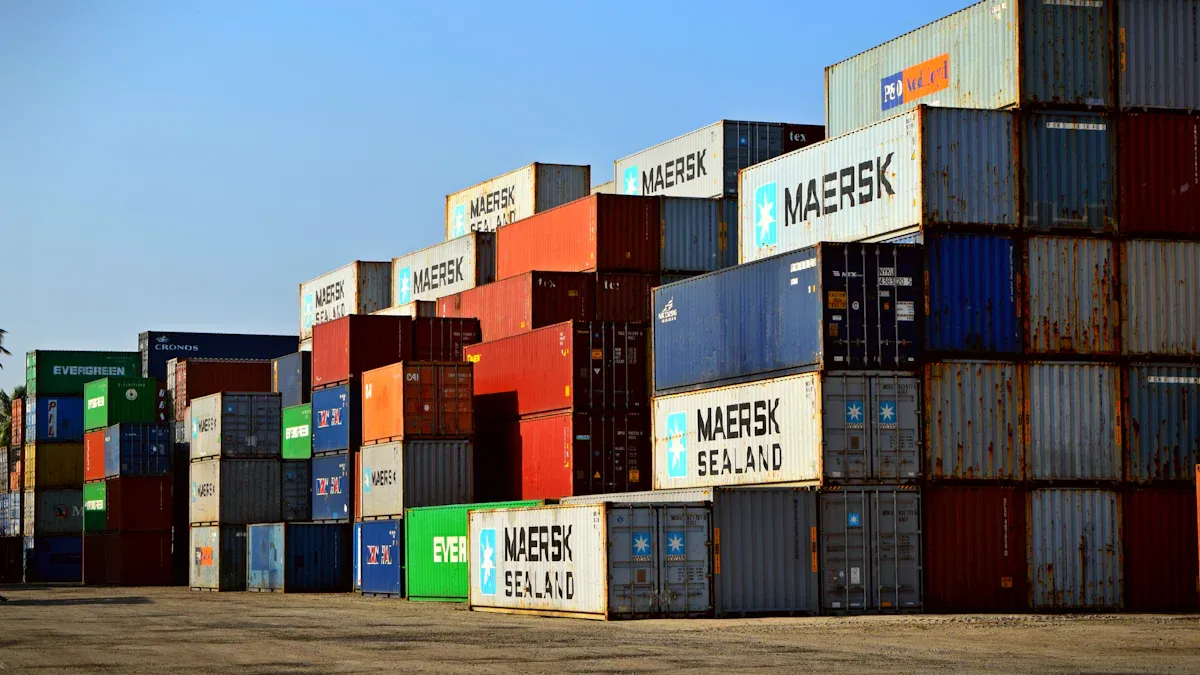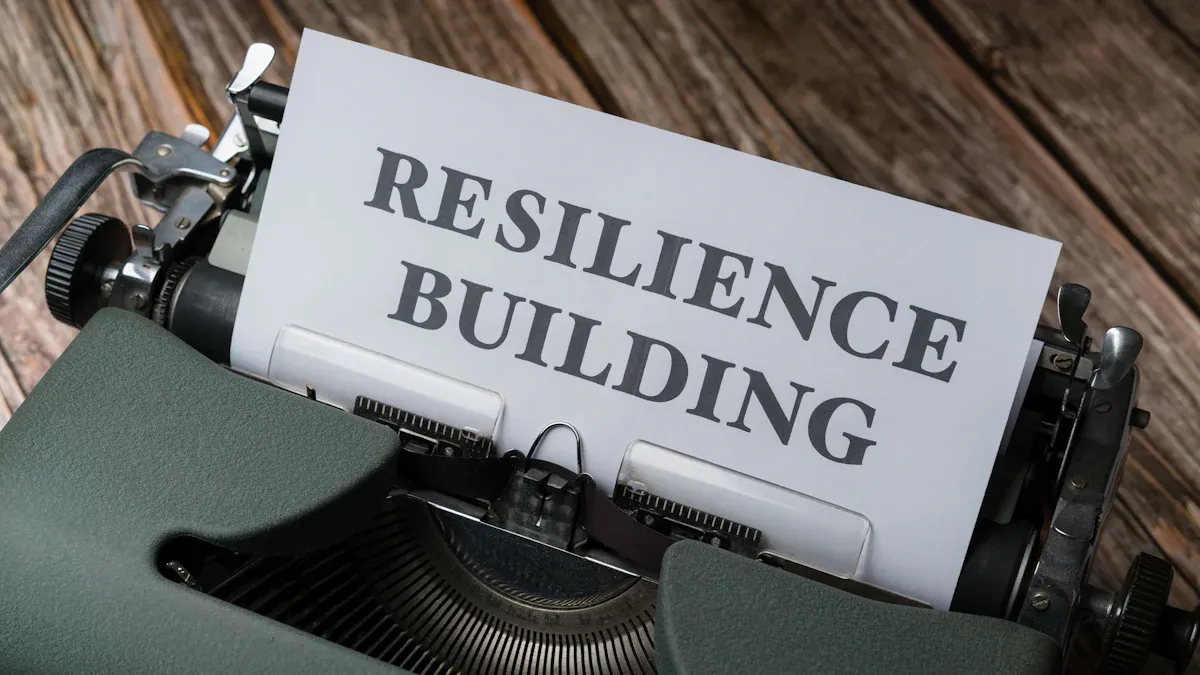The Critical Role of Supply Chain Orchestration in Resilience

Supply chain orchestration stands as a cornerstone for business resilience. It unifies operations across departments, enabling teams to act as one. Companies that leverage supply chain orchestration benefit from real-time monitoring and early disruption detection.
- Analytical tools provide actionable insights, helping teams respond faster to unexpected events.
- Integration across the value chain increases collaboration and speeds up information flow.
- Real-time data access allows quick adjustments to production and inventory, reducing delays.
Organizations that invest in supply chain orchestration technologies see improved agility, faster decision-making, and lower risk during disruptions.
Supply Chain Orchestration

Definition
Supply chain orchestration is a strategic approach that synchronizes and optimizes every part of the supply chain, from procurement to delivery. Companies use advanced technologies and data-driven insights to gain a complete view of their operations. This approach helps identify bottlenecks and apply smart solutions that improve efficiency and reduce costs. By breaking down barriers between departments, supply chain orchestration enables teams to work together smoothly. The process also reorganizes roles, processes, and technologies to create seamless flows from planning through delivery. Companies rely on tools like ERP systems, analytics, and IoT devices to achieve real-time visibility and collaboration. This transformation turns the supply chain into a smart, responsive system that delivers better performance and customer satisfaction.
Orchestration vs. Traditional Management
Traditional supply chain management often separates functions like procurement, manufacturing, and logistics. Each team works independently, which can cause problems if one area faces a disruption. In contrast, supply chain orchestration connects all functions, both inside and outside the company, much like a conductor leads an orchestra. This method allows for real-time planning and execution, using AI and analytics to respond quickly to changes. For example, Spirit AeroSystems reduced inventory by 16% and improved on-time delivery by 20% by synchronizing workflows across teams and suppliers. Toyota uses orchestration to balance inventory and adapt quickly to market needs. These results show that orchestration offers better integration, efficiency, and risk management than traditional supply chain management.
Value Chain Unification
Unifying the value chain means connecting every activity, from product design to delivery, into one coordinated process. A European distribution company improved its supply chain by standardizing products, unifying installation costs, and delaying big investments until needed. These steps reduced costs and made the supply chain more resilient. Industry research shows that digital technologies help unify value chain activities, leading to better efficiency and resilience. When companies coordinate their value chain, they see lower costs, optimized resources, and stronger risk management. This unified approach supports end-to-end orchestration, helping organizations adapt to changes and deliver consistent results.
Modern Challenges
Disruptions
Supply chains today face a wide range of disruptions that threaten stability and performance. Over the past five years, companies have dealt with:
- Natural disasters
- Man-made disasters
- Supplier issues
- Transportation problems
- Demand volatility
- Inventory shortages
- Regulatory changes
- Cyberattacks
- Geopolitical conflicts
- Labor strikes
- Climate-related events
Major events such as the Covid-19 pandemic, the Suez Canal obstruction, and the Russia-Ukraine war have shown how quickly disruptions can spread across global networks. Ongoing challenges like port congestion and extreme weather events continue to test the resilience of supply chain management. These disruptions highlight the urgent need for real-time transparency and rapid response capabilities.
Visibility Gaps
Many organizations struggle with visibility gaps that limit their ability to monitor and manage supply chain activities. Without full transparency, companies experience delays, inefficiencies, and loss of customer trust. Only 6% of companies report having complete visibility, while 79% admit to lacking sufficient insight into their operations.
| Aspect | Data / Impact |
|---|---|
| Organizations lacking sufficient visibility | 79% |
| Companies with full visibility | 6% |
| Impacts | Delays, financial losses, stranded containers, damaged trust |
| Causes | Fragmented data, poor integration, weak technology, lack of collaboration |
| Economic impact | Billions lost annually |
Transparency enables better decision-making, inventory control, and customer service. As consumer expectations rise, companies must invest in technology to close these gaps and maintain a competitive edge.
Operational Silos
Operational silos create barriers that block the flow of information and hinder collaboration. Teams often work in isolation, leading to an "us versus them" mentality. This mindset causes delays, higher costs, and reduced service quality. Silos can appear as information gaps, poor communication, or financial divisions. When units focus on their own goals instead of the entire supply chain, transparency suffers and risks increase. Breaking down these silos is essential for unified supply chain management and building resilience.
Orchestration Technologies
End-to-End Visibility
Modern supply chains rely on end-to-end visibility to achieve 360-degree transparency. Companies use an integrated platform to bring together data from transportation, warehousing, inventory, and orders. This approach provides real-time visibility and supports predictive analytics.
- Procurement teams use AI-driven predictive analytics to monitor supplier performance and ensure timely deliveries.
- Manufacturing teams apply predictive analytics for demand forecasting, reducing downtime and waste.
- Inventory managers use IoT-powered tracking, RFID, and BLE solutions to maintain accurate stock levels.
- Logistics teams implement GPS-enabled route optimization and smart fleet tracking for real-time visibility and delivery efficiency.
- Customer fulfillment benefits from accurate ETAs and faster returns, improving satisfaction.
Cloud-based platforms with open APIs and strong cybersecurity protocols support end-to-end transparency. These tools break down silos and enable seamless integration, making supply chain visibility possible across all operations.
Automation & Integration
Automation transforms supply chain orchestration by streamlining repetitive tasks and integrating processes. Companies automate back-office tasks like invoice processing and data entry, reducing errors and speeding up operations. Logistics automation optimizes freight scheduling and tracking, while warehouse automation with AI-powered robots boosts efficiency during labor shortages.
Real-time inventory management uses predictive analytics to automate reordering and align with demand.
Automated quality checks with computer vision improve defect detection and consistency. By integrating all supply chain processes into a unified platform, companies gain end-to-end visibility and contextualized data. This integration allows quick responses to disruptions, prevents downtime, and supports proactive decision-making.
AI, IoT, and Analytics
AI, IoT, and analytics drive predictive insights and operational excellence. Companies use predictive analytics and machine learning for anomaly detection, automated decision-making, and pattern recognition. IoT sensors and GPS provide continuous, automated data collection on asset location and condition, supporting real-time visibility.
| Company | Technology Used | Measurable Benefits |
|---|---|---|
| Amazon Pharmacy | AI-driven demand forecasting | 50% better forecasting; 13% less manual planning time |
| Tru Earth | AI + IoT + RFID for inventory tracking | Improved real-time inventory visibility and accuracy |
| Walmart | Predictive analytics & blockchain | Faster traceability; prevented $120M in losses |
| Accenture | Real-time control towers | 20% lower inventory costs; better on-time delivery |
These technologies enable predictive analytics, dynamic inventory optimization, and automated replenishment. Control towers and unified commerce platforms further enhance transparency, allowing organizations to make proactive, data-driven decisions and build resilient supply chains.
Resilience Benefits

Risk Management
Supply chain orchestration strengthens risk management by coordinating resources and processes across the entire value chain. Companies that orchestrate their supply chains can identify, assess, and address risks before they escalate. A study based on Resource Orchestration Theory shows that effective coordination within and between supply chain partners increases both resilience and robustness. Resilience means the ability to recover quickly after a disruption, while robustness refers to maintaining operations during unexpected events. Survey data from 388 supply chain executives confirms that orchestration improves readiness, response, and recovery. AI integration amplifies these benefits, helping organizations prepare for and manage risks more effectively.
Organizations that implement orchestration technologies experience measurable improvements. For example, PepsiCo increased pallet movements by 30-35% at pilot sites, while in-line efficiency rose by up to 20%. On-time rates improved by 5%. These gains reflect better risk management and operational resilience. Companies also see up to a 1% increase in revenue, a 3-5% reduction in logistics costs, and a 10-20% improvement in labor efficiency. These results highlight the direct link between orchestration and business continuity.
Note: Key performance indicators such as inventory accuracy, on-time delivery, and supplier performance index help organizations track risk management success and ensure continuity.
Agility & Adaptability
Agility and adaptability are essential for long-term success in today’s fast-changing markets. Supply chain orchestration enables companies to respond quickly to disruptions and shifting customer demands. Automation and orchestration support faster decision-making and operational flexibility. In 2022, 83% of supply chain leaders reported that investments in resilience helped minimize the impact of disruptions. By 2025, 70% of organizations plan to implement structured automation, up from 20% in 2021.
- Automation reduces delays and bottlenecks, leading to faster time-to-market.
- AI-enhanced orchestration automates repetitive tasks, freeing employees for strategic work.
- Real-time data orchestration provides visibility and control, allowing supply chains to pivot quickly.
Industry reports show productivity improvements of 10-20% in the short term and 20-40% over two to four years due to automation. Research also demonstrates that combining agility with sustainability practices leads to higher performance. Orchestration coordinates resources and practices, supporting dynamic adaptability and continuous improvement. These capabilities help organizations achieve long-term success and maintain operational resilience.
Proactive Decisions
Supply chain orchestration empowers proactive decision-making by integrating data, processes, and communication across the value chain. Companies align supply planning with logistics management, allowing them to manage logistics capacity based on sales forecasts. They optimize critical stock levels by combining demand forecasts, current inventory, and real-time tracking. Integrated communication ensures timely adjustments to sales or purchase orders and transportation plans.
Technologies such as ERP systems and transportation orchestration platforms provide end-to-end visibility, milestone prediction, and risk monitoring. Advanced analytics and AI enable demand prediction, inventory optimization, and real-time decisions. IoT devices collect operational data, track shipments, and support predictive maintenance.
Organizations realize several benefits after implementing orchestration:
| Benefit | Quantifiable Improvement |
|---|---|
| Pallet movements | 30-35% increase at pilot sites |
| In-line efficiency | Up to 20% increase |
| On-time rates | 5% increase |
| Revenue | Up to 1% increase |
| Logistics cost reduction | 3-5% reduction |
| Labor efficiency | 10-20% improvement |
These improvements optimize supply chains, minimize risks, and support long-term success. Companies that use orchestration technologies gain seamless end-to-end visibility, increased agility, and efficiency gains through automation. This approach ensures that organizations can make informed decisions, avoid disruptions, and maintain business continuity.
Implementation Steps
Assess & Plan
Organizations begin their journey by assessing the current state of their supply chain. Leaders identify gaps, strengths, and opportunities for improvement. They build a business case for change, showing how orchestration can align with strategic goals and deliver measurable benefits. A detailed roadmap follows, outlining milestones and expected outcomes.
Step-by-step approach:
- Assess the current supply chain landscape and maturity to spot gaps and opportunities.
- Build a compelling business case, quantifying improvement potential and aligning with company strategy.
- Create a transformation roadmap with clear milestones and outcomes.
- Secure cross-functional engagement by targeting stakeholder groups with tailored communication.
- Align talent strategy with supply chain planning, designing an organizational structure that supports digital transformation.
- Collaborate with HR to develop a talent management approach, including recruiting, training, and performance management.
- Integrate supply chain planning with other business processes to boost maturity and performance.
- Establish KPIs to monitor and drive continuous improvement.
Tip: Early engagement with stakeholders and clear communication of benefits help overcome resistance and foster collaboration.
Adopt Technology
Selecting the right technology is critical for successful supply chain orchestration. Organizations analyze their existing processes, data flows, and partner networks to identify weaknesses and opportunities. They choose a platform that offers data integration, real-time transparency, and automation. The platform must integrate seamlessly with existing ERP, TMS, or WMS systems.
Key criteria for technology adoption include:
- Alignment with the organization's supply chain maturity stage.
- Seamless integration with current systems for comprehensive data flow.
- High data quality, ensuring accuracy and timeliness.
- Cross-departmental collaboration to break down silos.
- Scalability and adaptability to meet changing business needs.
- End-to-end visibility, automation, and real-time decision-making capabilities.
- Strong vendor partnerships to ensure alignment with strategic goals.
- Structured, incremental implementation with clear goals and a mindset of continuous improvement.
Organizations also consider advanced technologies such as artificial intelligence for analytics, IoT for real-time monitoring, and blockchain for transparency. These tools enable proactive risk management and support the orchestration process.
Align Processes
Process alignment ensures that all functions work together toward shared goals. Leaders measure alignment using metrics such as schedule adherence, response times, resource utilization, and inventory optimization. They use integrated planning systems, AI, and IoT to provide real-time data and automate workflows.
| Aspect | Measurement Methods | Improvement Strategies |
|---|---|---|
| Process Alignment | Schedule adherence, response times, resource use | Integrated planning, AI/IoT, structured automation |
| Operational Efficiency | On-time delivery, order cycle time, perfect orders | Technology integration, performance measurement, adaptability culture |
| Financial Impact | Total cost, working capital, EBIT margins | Align scheduling/procurement with strategy, leadership, cross-functional collaboration |
Organizations digitize procurement and other processes, using technology to enhance transparency and supplier performance tracking. Strong leadership, effective communication, and cross-functional collaboration help overcome resistance to change. Automation reduces errors and provides real-time data, improving synchronization across the supply chain.
Note: Breaking down silos and fostering a culture of collaboration are essential for process alignment and long-term success.
Continuous Improvement
Continuous improvement keeps supply chain orchestration effective over time. Companies regularly review and refine strategies to adapt to market changes, customer needs, and new technologies. They assess current processes to find bottlenecks, explore new tools, and reorganize teams as needed.
Effective methodologies include:
- Regular process reviews to identify inefficiencies.
- Adoption of new technologies such as robotics, AI, and intelligent automation.
- Collaboration and inclusive decision-making to ensure alignment.
- Investment in training and certification to build necessary skills.
- Integration of multiple data sources into a digital twin for real-time visibility and scenario modeling.
Supply chain orchestration enables proactive management, shifting from reactive to data-driven decisions. Managers use real-time data to optimize labor, resources, and processes. Extending orchestration beyond warehouses to transportation and returns management further reduces inefficiencies.
Continuous adaptation and collaboration across the value chain are vital. Companies that invest in ongoing improvement sustain resilience and maintain a competitive edge.
Supply chain orchestration stands as a strategic necessity for building resilient, future-ready supply chains. Companies gain risk management, agility, adaptability, and proactive decision-making. Business leaders recognize orchestration as a driver of revenue growth and competitive advantage.
- Future trends include increased automation, advanced analytics, and a focus on sustainability and transparency.
- Organizations benefit from real-time visibility, predictive modeling, and streamlined operations.
| Company | Results |
|---|---|
| Global Manufacturer | 15% logistics cost reduction, $300M+ savings |
Leaders should start with clear frameworks, invest in technology, and empower teams to drive transformation.
FAQ
What is the main goal of supply chain orchestration?
Supply chain orchestration aims to connect all parts of the supply chain. It helps teams work together, share information, and respond quickly to changes. This approach increases efficiency and reduces risks.
How does orchestration improve supply chain visibility?
Orchestration uses technology to collect and share real-time data. Teams can see inventory, shipments, and orders at every stage. This visibility helps companies spot problems early and make better decisions.
Which technologies support supply chain orchestration?
Key technologies include AI, IoT, cloud platforms, and automation tools. These systems track goods, analyze data, and automate tasks. Companies use them to improve speed, accuracy, and collaboration.
Can small businesses benefit from supply chain orchestration?
Yes, small businesses can use orchestration to improve operations. They can start with simple tools and scale up as they grow. Orchestration helps them compete by increasing agility and reducing costs.
What are common challenges when implementing orchestration?
Companies often face resistance to change, data integration issues, and skill gaps. Clear communication, training, and strong leadership help teams overcome these challenges and succeed with orchestration.
See Also
Driving Business Expansion Through Outsourced Supply Chain Solutions
How Lean Logistics Enhances Sustainability In Supply Chains
Understanding How Technology Improves Supply Chain Performance
Key Features That Differentiate WarpDriven ERP For Smart Enterprises
Strategies To Secure Long-Term Success In B2B Order Fulfillment